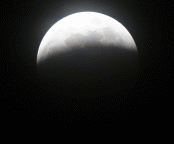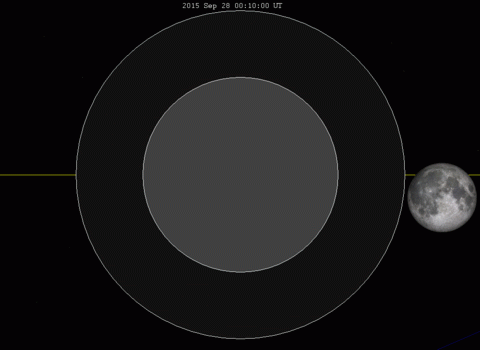What is round and red with a cape? It’s not super-tomato is super full moon eclipse! In the night from Sunday to Monday, our natural satellite will spend a few hours in the shadow of the Earth and adorn a beautiful crimson tint, at the crucial moment when he will be close to the Earth. Knowing that such a phenomenon will not come until the year 2033, it’s now or never to set his alarm clock to 3 o’clock in the morning, draw a line half the night and assume the zombie that pulls ‘we dragged Monday to work.
A super-Moon for awesome pics
As the Moon’s orbit is not circular, but slightly elliptical, the distance from the Earth to the Moon varies between 356,000 kilometers (the “perigee”) 000 km and 407 (the “apogee”) approximately. The more she approaches us, the more it seems big, although the difference is of course subtle to the naked eye. And when his big diameter coincides with the full moon night looms particularly conducive to observation. The event was named “Super Moon” in 1979 by astrologer Richard Nolle’s. This is what will happen in the night from Sunday to Monday: to 356 896 kilometers from us, the moon has not been this close since 2014, and in addition, it will be full
. Owners of good cameras can start charging their batteries: it will not be difficult to capture the event with a tripod. The September / October issue, the magazine Sky and Space advise apprentices astrophotographers sensitivity from 400 to 800 ISO, and exposure time of a few seconds.
A shadow blood red
 But it was 2:11 am, French time, the hard work begins: the Moon will pass in the shadow of the Earth and deprive gradually from sunlight until the total eclipse, where the three bodies will be perfectly aligned. We then expect the moon turns black … but it is a dark orange cape she will take. Where do the few rays of light that illuminate while? Always the Sun, but deflected by the gravity of the Earth and filtered through the atmosphere. Its color during a total eclipse it is sometimes called “bloody moon” Blood Moon in English
But it was 2:11 am, French time, the hard work begins: the Moon will pass in the shadow of the Earth and deprive gradually from sunlight until the total eclipse, where the three bodies will be perfectly aligned. We then expect the moon turns black … but it is a dark orange cape she will take. Where do the few rays of light that illuminate while? Always the Sun, but deflected by the gravity of the Earth and filtered through the atmosphere. Its color during a total eclipse it is sometimes called “bloody moon” Blood Moon in English
The event takes place in several steps. – First , Moon enters the area of the “penumbra” in which it does not lose a little brightness. We will not notice much to the naked eye. Then, from 3:07, it will pass in full shade and it will become clear that one of its edges darkened. Provide a chair, a coat and cookies, as the back under the duvet is not for now: the eclipse reaches its maximum at 4:11. No more ray of sun will then strikes the Moon without blushing first in the Earth’s atmosphere. The Moon will continue to darken until 4:51, color slightly varies over time, and will do the reverse path back to direct sunlight to 5:23. The output of the shadows will be at 6:27, out of the darkness at 7:22, and breakfast at 7:45.

This animation Tomruen (Wikimedia Commons, CC BY SA) gives a very clear idea of what we will have to put in the eyes on four continents that benefit the show: South America, Europe, and large parts of Africa and North America. The most motivated observers may even take the car at night or pitching a tent in one of the sites reserved observations by amateur astronomers all over France, to watch the moon in good company.
No comments:
Post a Comment